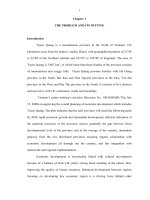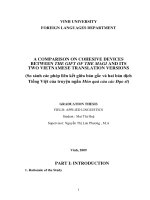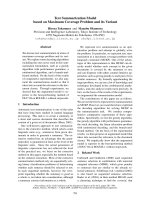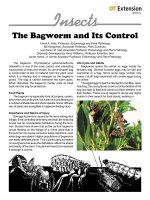THE PROBLEM AND ITS SETTING
Bạn đang xem bản rút gọn của tài liệu. Xem và tải ngay bản đầy đủ của tài liệu tại đây (277.33 KB, 66 trang )
1
Chapter 1
THE PROBLEM AND ITS SETTING
Introduction
Tuyen Quang is a mountainous province in the North of Vietnam, 165
kilometers away from the nation’s capital, Hanoi, with geographical position of 21o30'
to 22o40' of the Northern latitude and 103o53' to 105o40' of longitude. The area of Tuyen
Quang is 5,867 km2, of which more than three fourths of the province consists of
mountainous and craggy hills. Tuyen Quang province borders with Ha Giang province
in the North, Bac Kan and Thai Nguyen provinces in the East, Yen Bai province in the
West and Phu Tho province in the South. It consists of five districts and one town, with
141 communes, wards and townships.
Vietnam’s prime minister's decision (Decision No. 100/2008/QD-TTg July 15,
2008) on approving the overall planning of economic development which includes
Tuyen Quang. The plan indicates that the said province will reach the following goals
by 2020: rapid economic growth and sustainable development, efficient utilization of
the potential resources of the province, narrow gradually the gap between fiscal
developmental level of the province and to the average of the country, immediate
getaway from the less developed provinces ensuring organic relationship with
economic development all through out the country, and fast integration with nationwide
and regional implementation ..
Economic development is inextricably linked with cultural development
because of a balance of both will yield a strong fiscal standing of the nation, thus,
improving the quality of human resources. Balanced development between regions
focusing on developing key economic region is a driving force behind other developing
2
regions and reduces the gap in living standards between the strata. To well implement
the national policies and poverty reduction policies for disadvantaged areas, there
should be a cooperation between the government and the citizens in order to gradually
improve the quality of life. (Decision no. 100/2008/QĐ-TTg July 15, 2008 of Prime
Minister Approving the overall planning of economic development - Tuyen Quang
province in to 2020 )
In achieving these objectives, there should be measures to improve the
environment in order to attract investors through the country’s tourism sector in which
capital has important implications in both theory and practice. Other factors affecting
the growth of Vietnam’s economy are labor, and capital intensive technology are also
important. Practices that are involved in improving the role of the environment attract
investment which stengthens the process of economic and social development in Tuyen
Quang province.
Background of study
In the process of industrialization modernization capital investment has always
been considered a problem among developing countries. How to mobilize sources of
capital (both sources inside and outside sources) to meet requirements of the
modernization, is always a challenge to the country on the path out of poverty.
Therefore, competition between countries as well as local authorities in a country to
attract foreign investment capital is becoming more heightened.
International investment is currently a hot issue and an interesting topic in the
world. International investment contributes to the economic growth and brings positive
effects for the countries receiving capital investment and export among countries.
3
The role of international investors is becoming significant to the economic
development of countries in transition from planning economy to centralized economy
like Vietnam. To achieve a certain growth both in economic and social demands of
these countries, thorough utilization of the resources can be done for the investment to
be reasonable and effective.
Tuyen Quang is entering a new period of development, promoting
industrialization and modernization together with strong social democratic civilization.
In this context the need for capital investment and development is very important and
urgent. However, in recent years investing in Tuyen Quang are issues that need
attention, especially direct investment from abroad. As planned, socio-economic
development in Tuyen Quang province aims to speed economic growth (GDP) to
14.5% (Decision no. 100/2008/QĐ-TTg July 15, 2008 of Prime Minister Approving the
overall planning of economic development - Tuyen Quang province in to 2020 ) over
the period 2010-2015, of which capital requirements for investment and development is
45,000 billion. During this period, budget can only meet about 9000 billion
(approximately 20-25%) (Decision no. 100/2008/QĐ-TTg July 15, 2008 of Prime
Minister Approving the overall planning of economic development - Tuyen Quang
province in to 2020) as the rest are investment firms, credit and foreign investment.
Thus the short term and the long term solution in order to attract more foreign
investment capital, especially direct investment from abroad is to create a force that
pushes for the economic development. Departing from that practice, the researcher
intends to conduct a study entitled "Investment Environment in Tuyen Quang Province:
A Prospect for Development ".
4
Statement of the Problem.
This study intends to evaluate the investment status and identify investment
prospects for the development of Tuyen Quang Province. Specifically, it sought to
answer the following questions:
1. What are the investors’ profiles in Tuyen Quang Province as
indicated by their:
1.1 Type of Business Ownership;
1.2 Nature of Business;
1.3 Business Size;
1.4 Investor's Location;
1.5 Capitalization.
2. What is the present investment environment in Tuyen Quang Province
in terms of the following factors:
2.1 Political;
2.2 Legal - administration;
2.3 Geographic location and infrastructure;
2.4 Economic and financial;
2.5 Labor.
3. What are the problems encountered by the investors in terms of
3.1 Political,
3.2 Legal - administration;
3.3 Geographic location and infrastructure;
3.4 Economic and financial;
3.5. Labor.
5
4. What possible solutions could be proposed to overcome the problems
identified and to attract more investors in further developing Tuyen Quang
province?
Scope and Delimitation
The topics related to this study are Economics, Finance, Law and International
Relations. However, due to the scope time and the research activities will manly focus
on direct investment in Tuyen Quang province for 2006-2010. Subjects focused
research is investor have licensed investment certificates, and the investment
environment. time since the government promulgated the general investment law effect
in 2006.
Significance of Study
This study will be beneficial to the following:
For the Provincial Level:
Research shows that the strengths and weaknesses of the investment environment so
that a solution to improve investment environment to attract resources from outside the
province such as investment capital, science technology, scientific management also
exploit and promote the province's comparative advantage in minerals, forest resources,
tourism resources and abundant labor resources of the province
6
Research on the investment environment to provide information on enterprises
operating business in the province, review scientific evidence for the leadership of the
provincial to building strategy of economic development - social, open reform, poverty
reduction, implementation of modernization and modern industrial.
For communities:
Research to detect obstacles in the process of business activities from which to
support and removal of difficulties and improve the competitiveness of the business
community.
Improve the investment environment to attract domestic investors and foreign investor
in the province also means creating more jobs, raise incomes, improve living standards
for people, besides enjoying The main advantage of the welfare projects such as
electricity, roads, schools, health ...
For future researchers:
This study will help future researchers on research methods, analysis and
evaluation of investment environment of the province from which researchers’ future
studies will determine the issues for further studies
Definition of Terms:
7
Business Size is the maximum capitalization of a project investment.
Capitalization is the sum of a corporation's long-term debt, stock and retained
earnings.
Direct investment is a form of investment by which investors are participating directly
in investment management activities.
Domestic investment is a form of investment that the investor-owner as well as
investment capital - the capital of the country to leave the operating organization and
business activities in order to target for profitability and take responsibility for the
capital, as well as the results of its business operations.
Investment environment consists of legal, economic, political, cultural, and social
factors which affects directly or indirectly to the operation and foreign investment of a
country.
Foreign Direct Investment is thought to be more useful to a country than investments
in the equity of its companies because equity investments are potentially "hot money"
which can leave at the first sign of trouble, whereas FDI is durable and generally useful
whether things go well or bad. ( />
Investment refers to capital in tangible assets or intangible assets
8
Investment law in 2005, defines: Investor is an individual who commits money to
investment products with the expectation of a financial return. Generally, the primary
concern of an investor is to minimize risk while maximizing return, as opposed to a
speculator, who is willing to accept a higher level of risk in the hopes of collecting
higher-than-average profits.( />
Political environment includes all laws, government agencies, and lobbying groups
that influence or restrict individuals or organizations in the society.
9
Chapter 2
REVIEW OF RELATED LITERATURE AND STUDIES
Foreign Literature
Investment is defined as any use of resources intended to increase future
production output or income. Investment is "to spend, to sacrifice" in existing resources
to achieve results beneficial in the future. In other words, investment is the sacrifice of
current benefits for a great benefit of income in the future.
Resources may be in the form of money, natural resources, labor and intellectual
capital. The results can be achieved through financial assets, physical assets, intellectual
property and human resources qualification and recognition to work with higher
productivity in any business entitiy.
There are many criteria for the classification of an investment; we can divide
investors into three main categories: Financial investment which is a type of
investment that people lends money or purchases price for certificates with
predetermined interest, Trade investment which is a type of investment that people
have money to buy goods and sell them for a higher price to earn a profit and
Investment in Development in which people carry out activities to create new assets
for the economy, increase the potential production of a business and social activities
Therefore it is a condition to create jobs and improve the lives of all people in the
society.
Foreign direct investment resources (FDI)
10
Foreign direct investment reflects the objective of obtaining a lasting interest by a
resident entity in one economy (‘‘direct investor’’) in a resident entity of an economy
other than that of the investor (‘‘direct investment enterprise’’). The lasting interest
implies the existence of a long-term relationship between the direct investor and the
enterprise and a significant degree of influence on the management of the enterprise.
Direct investment involves both the initial transaction between the two entities and all
subsequent capital transactions between them and among affiliated enterprises, both
incorporated and unincorporated.(www.oecd.org/dataoecd/10/16/2090148.pdf)
Balance of Payments Manual: Fifth Edition (BPM5) (1993) and the Detailed
Benchmark Definition of Foreign Direct Investment: Third Edition (BD3) (1996 refer
FDI to an investment made to acquire lasting interest in enterprises operating outside of
the economy of the investor. Further, in cases of FDI, the investor’s purpose is to gain
an effective voice in the management of the enterprise. The foreign entity or group of
associated entities that makes the investment is termed the "direct investor". The
unincorporated or incorporated enterprise-a branch or subsidiary, respectively, in which
direct investment is made-is referred to as a "direct investment enterprise". Some
degree of equity ownership is almost always considered to be associated with an
effective voice in the management of an enterprise. It also suggests that a threshold of
10 per cent of equity ownership is required to qualify an investor as a foreign direct
investor.
Once a direct investment enterprise has been identified, it is necessary to define which
capital flows between the enterprise and entities in other economies should be classified
as FDI. Since the main feature of FDI is taken to be the lasting interest of a direct
investor in an enterprise, only capital that is provided by the direct investor either
11
directly or through other enterprises related to the investor should be classified as FDI.
The forms of investment by the direct investor which are classified as FDI are equity
capital, the reinvestment of earnings and the provision of long-term and short-term
intra-company loans (between parent and affiliate enterprises). Furthermore, a direct
investment enterprise is an incorporated or unincorporated enterprise in which a single
foreign investor either owns 10 per cent or more of the ordinary shares or voting power
of an enterprise (unless it can be proven that the 10 per cent ownership does not allow
the investor an effective voice in the management) or owns less than 10 per cent of the
ordinary shares or voting power of an enterprise, yet still maintains an effective voice in
management. An effective voice in management only implies that direct investors are
able to influence the management of an enterprise and does not imply that they have
absolute control. The most important characteristic of FDI, which distinguishes it from
foreign portfolio investment, is that it is undertaken with the intention of exercising
control over an enterprise.
Local literature Reviews:
The concept of environment to attract investment
The concept of environment to attract investment capital is a term mentioned in
both economics and business administration researches in many countries. In Vietnam,
the transition to market economy requires implementation of policies of innovation in
an open economy integrated with the world, thus, attracting foreign investment. The
environmental issues attract new investment capital and further reached to more
researches to address the environmental.
12
Environment to attract investment includes many factors which directly or
indirectly affects the efficiency of investment projects. The factors included are reality
of infrastructure; related to financial benefits such as tax regimes, labor costs, physical
assets, regulations on hiring, assignment, mortgage, prices, various administrative
procedures ensuring security and social order, political stability. If the above favorable
factors will encourage the investment and attract more investment capital, the country
will gear towards development and to solidify its stance, the government should also
participate in making policies to increase the confidence of investors.
Environment to attract investment capital that has the characteristics and
nature of the following: (1) objectivity: No single investor or a business exists in
isolation, it should exists objectively, it can facilitate or mediate difficulties for
investors. Environment to attract investment capital creates a binding surface for
investment activities, on the other hand, creating favorable opportunities for investors.
(2)
Integrated: Integrated in the sense that it includes many elements that have
relationships with each other. The number and the specific components of the
environment to attract investment depend on the level of development and socioeconomic, managerial and right main components of the environment. (3) Diversity:
Environment to attract investment capital is a mixture of environmental components.
Therefore, research and analysis is fundamental for the getting the overall correlation
between environmental components and the elements. (4) Dynamic: Environment to
attract investment capital and other elements mobilize the growing trend as it always
immediately transformed by the internal operations of investment which is also an
active process in a constantly changing environment. Factors and conditions of the
environment to attract investment capital affect investment activities of investment or
13
business activity on a regular basis. (5) Systematic: The stability of the environment to
attract investment depends on the complexity and variability of the interactive
environment. In order for the maneuvering of investments, systematic approach should
be dealt every now and then to assess its effectivity and to gauge its efficiency.
The process of selecting investment location:
In most cases, choose the location of TNC investments are carried out by three
steps: (1) Company selected a potential area to invest in it, (2) Some of the potential
area was selected; (3) The location of potential in that country is determined. The main
factors to evaluate the investment location: (1) Market: growth and size of the market,
income per capita, import barriers, consumer preferences specific of that country (2)
Cost: cost, quality, availability and productivity of workers trained / can be trained; The
cost inputs, components and raw materials; The costs of transportation,
communications and utilities; tax, financial costs, access and availability of foreign
currency; preferences and disadvantages to investment trade (3) Natural resources: The
availability of natural resources (4) Infrastructure: physical infrastructure (roads,
seaports, airports, telecommunications) infrastructure technology, research and
development school) infrastructure industry (research institutions, universities and
outsourcing business, the supply industry, industrial clusters); educational infrastructure
(schools, colleges, universities) (5) Policy Framework: The stable economic, political
and social; development policies of private sector and privatization of state enterprises;
rights, warranties and incentive structure and operation of the market; the international
agreements on trade and the legal system in general.
14
Main proclivities of FDI.
The list of FDI investors is not only limited to search market and investors looking
for natural resources; instead, investors looking for efficient and strategic search assets
today is also on the list and given due importance. In addition, most investors around
the world are in the service sector, although this may not be true for FDI situation in all
countries.
Venture is still a common form using a variety of other arrangements including
strategic alliances, networks, agreements other non-capital. Activities merger and
acquisition is also an important form of FDI.
The relationship of history and geography impacts the current crisis. In addition,
the FDI flow to foreign countries often shows the comparative advantage and
competitive strategies of the country to invest. Therefore, linkages of geography,
history and other link made the basis for selection of investors.
The economic benefits from FDI.
The following are the benefits brought by FDI: (1) Employment: While the number
of jobs created are suitable for different scales of investment and production process
itself and along with new jobs and income is additional purchasing power for local
people, (2) Benefits of revenues: FDI has the potential to expand the tax base of local
revenues and contribution to government revenues. Even if foreign investors are
exempt from all taxes for a short period through investment incentives, the government
can get increased revenues from personal income tax return because FDI creates new
jobs. In addition, export-oriented investments generate foreign currency revenues. (3)
15
Impact favorable to investment in the country: The FDI flow tends to increase domestic
investment because the company is for access of distribution channels opened by the
TNC, (4) Technology Transfer: FDI can improve access to the country's technology
through licensing and joint ventures. Those working for TNC can handle the secrets
they have and set up another company or participate in companies active in the country.
Although kind to another, transfer of technology tends to lead to growth in increasing
productivity, (5) Improving the skills of workers: The TNC engages in activities that
improve the skills of its workers. These skills are often transferred to other fields and
other activities when employees find new jobs or setting up his own business. Workers
also often placed on organizational skills and new management, which may stimulate
increased productivity, mental work and thorough learning, (6) Improved export: Many
FDI projects are export-oriented projects, and generally take an average portion of
exports of the country receiving investment. Through the access to
network of
marketing and distribution overseas, the foreign companies are generally easier to
penetrate the export market. Many developing countries know how to use FDI as a
means to increase their export revenues and improve foreign currency. In addition, the
presence of exporting companies invested abroad is an influential factor in many
countries to encourage domestic companies in order to penetrate the export market, (7)
Improved international competitiveness of companies in the country: Opportunities in
the marketing of products or materials for companies invested abroad encouraged
domestic companies to improve product quality and reliable delivery. Foreign
companies usually offer new products for the domestic economy, and domestic
companies are often encouraged to copy these products.
This stimulates investment achieving higher level of investment, productivity and
innovation creation. As a result, domestic companies achieve greater economic
16
efficiency and produce higher quality products, (8) Strengthening competitiveness: FDI
can improve the overall economic growth by enhancing competition in areas formerly
been dominated by only one or two companies in the country.
Forms of foreign direct investment in Vietnam.
Currently, Vietnam has three main forms of investment following: (1) Enterprises
with 100% foreign capital in which a business is owned and managed by foreign
investors, (2) Joint venture which is an enterprise established by foreign investors
contributing capital with organizations and individuals on the basis of joint-venture
contract. The parties involved with operating companies, distribution of profits as well
as risk reduction of capital between the respective parties. The type of business is a
limited liability depending on the scale of investment and investment fields that the
time limit for each venture investment will be different, (3) Business cooperation
contract, in which there is an agreement between two parties and there are two or more
defined responsibilities and the division of business results for each party to conduct
investment business without a legislative personnel.
Investment Environment
The investment environment is defined as a set of specific factors that are shaping
the local to the opportunities and motivation for enterprises to invest efficiently and
create jobs and expand production. Thus, the investment environment is considered
Synchronization or set of factors may increase the ability of interest (or risk) to
investors abroad. The problem arises as we must learn all the components of the
17
investment environment to improve it and attract more investors to come and do
business.
Investment Environment Equality and Competition
Investment is one of the main activities of the process of economic integration. The
economic integration in the international investment activities are conducted through
two basic principles: (1) Principle of national treatment in investment activities and NT
Principles (National Treatment): country receiving FDI commitment to win the
favorable investment conditions (incentives). In essence, the guidelines are directed to a
common purpose which is to create equal business environment, investment
environment, and equality between investors.(2) Most Favored Nation principle in
investment activities - Guidelines MFN (Most Favored Nations): a country will win the
favorable conditions (incentive) to international investors, when they conducted the
investment on their national territory.
Thus, we can say that equality in investment activities are considered "habitat" of
the business. A good investment climate, ventilation will create favorable conditions for
the operation of enterprises in general; reverse investment environment was "polluted",
is the more problem, limited business development.
Competitive investment environment.
Competitiveness of the investment environment is the comparison of different
investment environment in the same criteria. Investment environment changes not only
between countries but even within one country. This occurs because of the differences
18
in the management of the country in general as well as policy and administrative
management of each locality in particular.
The components of investment environment
Political environment.
The political stability is a key factor to attract investors. Host country government
should have a reasonable policy to political stability and keep social stability in a long
time. The foreign policy of openness will attract the attention and support of countries
in the region, enticing them to join into the economic development of their countries.
Political stability is a prerequisite to ensure the government's commitment to investors’
property investment, the policy priority investment and investment-oriented structure in
from the country receiving investment.
The political stability is essential to maintain the balance of the economy. The
direct impact factors and inclusiveness increase or decrease risky investment activities.
The rule of thumb for investors in general and foreign investors in particular is the
safety of capital and interest because operating in unfamiliar environments, large
investment and long-time capital withdrawal should worry foreign investors for their
property being confiscated by the host country. Moreover, the unstable political
situation often leads to inconsistency. Incumbent government can not commit to the
property of foreigners in a foreign direct investment. Change of government also brings
threats to foreign investors for the safety of their assets. This is one reason why current
investment is often less in African countries and some other developing countries in
South America. In contrast, a stable political situation ensures consistent development
19
of the host country; thus committed to ensuring the safety for their legal property is
made. This is clearly reflected in many developing countries and new industrial
countries in Asia.
The political stability of a country also decides political environment in that
country. However, in the same country, regional environs tend to vary; and this will
directly affect economic activity and foreign investment. The government’s capacity is
also one of the factors to be considered because it can affect to such factors as
geographical location, natural resources, weather but the government has a strong
influence to ensure property rights, the regulatory and taxed (both inland and at the
gate), satisfaction level of infrastructure, the operation of financial markets, the
phenomenon of corruption and many other factors. This depends largely on the
operating capacity and moral quality of the team leaders of the country.
Legal administrative environment
Legal system is one very important factor which plays a crucial role in creating the
look of the investment environment. Legal system of a country can be expressed
through a number of features below:
- Build charter.
- Calculate fullness and synchronize.
- Calculate standard and integration.
- Righteousness, is professed and capability is realized
Geographic location and infrastructure environment
20
Geographic location affects the actions of investors. Convenience and accessibility
of a location is a big plus for an investor because both indicators present ways on how
to mitigate some risks involved in the process. Also, infrastructure which includes
system roads, and bridges, airports, seaports, telecommunication services and hotel
interests investors and guarantees invitation calls for very active investors abroad.
Geographical location and infrastructure of each country is different from one
another because of its natural conditions and resources yet, government’s participation
in addressing such pressing issues will settle the differences.
Economic and Financial Environment.
Each application of a common national economic policy depends on the individual
development level and the objectives in which a country will pursue. A country creating
favorable conditions to attract foreign capital sources must first implement open
economic policies that ensure the economic cohesion of the country to the world
market. This enables the country to participate in international division of labor; get
goals for all its economic activities not only serve the domestic demand but also the
needs of international market. In addition, the level of economic development of
countries receiving investment include the development of macroeconomic
management, infrastructure, provide quality services for business operations of the
foreign investment and competition of the market as well as host country factors have a
stronger impact for foreign investors.
On that basis, the economic environment - the resources of each locality will be
formed
in
accordance
with
the
situation
developed.
The ability to create a healthy financial environment and banking system is a
21
requirement set out in the process to improve the investment environment since no
investment projects do not relate to the settlement capital, credit and regulatory
supervision over monetary system. Financial background of a country is assessed
through indicators such as the international balance of payments, international trade
balance, inflation, exchange rates, and freely convertible currencies. Financial
environment of a locality is reflected through the banking system, finance companies,
stock market, and money market securities. These are the indicators which reflect the
stability of the macro economy.
Labor environment
The labor cost in countries where investors expected to invest influences greatly on
the efficiency of investment. The reason is that the labor force is plentiful low labor
costs will attract the attention of. However, the current labor cost factor in less
developed countries is no longer attractive for capitalist Since the revolution of modern
science and technology has allowed to hasten the automation process and improve labor
productivity. In such conditions, any of the staff workers who are trained to the level of
scientific is considered an advantage; as through employers, investors not only want to
record its benefits, but also to gain additional profit.
In addition, a stable working environment also shows the calculated hardwork and
spiritual discipline of the workers; and more importantly the strike situation and
removal of the workers, the union organizations are prevented. This is a quite sensitive
issue that an investor does not want to meddle with the host country.
The meaning of the research investment environment
22
To study the investment environment in host countries in improving economic
environment, speeding up the process of integration between regional and universal
economy, the selection strategy should be undermined in order to attract investors.
Many countries implement economic strategies that create and open an economic
environment. These factors stimulate and attract investment from a country; that it must
be established and perfected and should be adjusted continuously by the receiving
country the investment and goodwill of both parties resulting an economic engine.
INVESTOR PROFILE:
Conceptual Framework
Type of Business Ownership;
Nature of Business;
Business Size;
Investor's Location;
Capitalization
Input
PRESENT INVESTMENT
ENVIRONMENT
Political
Legal - administration
Geographic location and
infrastructure
Economic and Financial
Labor
CONCEPTUAL PARADIGM
INVESTMENT
ENVIRONMENT
IN TUYEN QUANG
Output
PROVINCE: A PROSPECT
FOR DEVELOPMENT
EVALUATION
23
Figure 1: Conceptual paradigm of assessment of the investment environment in Tuyen
Quang Province: A prospect for development.
For a better understanding, a conceptual model was used to guide the researcher
in conducting this study.
The study employed the Input – Process - Output model. The first frame,
which is the input, indicates the value of the existing of brand image through these
factors: Form of investment, Sector of investment, environment in Tuyen Quang
Province in terms of the following factors: Political; legal - administration; geographic
location and infrastructure; Economic and financial; Labor. The second frame, which is
the process, indicates the data gathering, evaluation through questionnaire checklist,
analysis and interpretation of data. The third frame, which is the output, indicates the
determined investment prospect yielding to a developed Tuyen Quang province.
24
Chapter 3
RESEARCH METHODOLOGY
This chapter discusses the research design, the firms‘ sample size and
sampling technique, the description of respondents, the research instrument, the data
gathering procedures and statistical treatment of data used by the researcher.
Research Design
25
In this study the researcher employed the descriptive method of research; it is
the appropriate method in determining the perception of firm about brand image of
Tuyen Quang province. Descriptive statistics were used to have an accurate portrayal of
strengthening the brand image.
This method was employed in this study because it is a fact – finding scheme
designed to enable a researcher to adequately and accurately interpret collected data, as
well as the result or findings.
Population, Sample size and Sampling Technique
In this study, the population was composed of 33 ongoing investment projects
managed by 33 directors. The population of all these 33 directors served as the
respondents. That is investor have licensed investment certificates. Time since the
government promulgated the general investment law effect in 2006.
Description of Respondents
Respondents of the study were 33 directors handling investment projects in
Tuyen Quang Province. Their responses described the present investment environment
in the province as well as the prevailing problems.
Research Instrumentation









